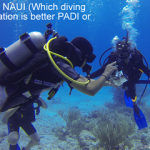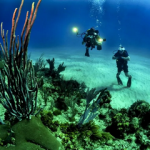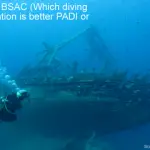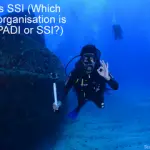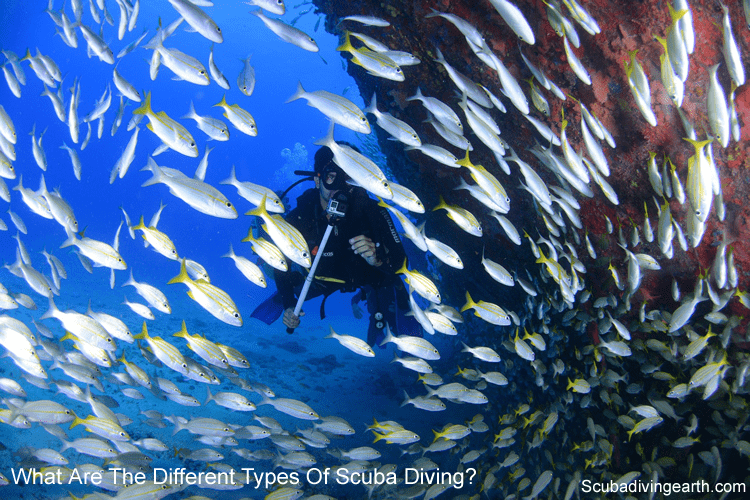
What are the different ‘types of scuba diving‘ and how to choose the best for you
After spending over 30 years as a scuba diver I’ve done most types of scuba diving. Now I know what I like and what I don’t like.
If you’re just starting out scuba diving, the best advice I can give is to try each of the types of scuba diving for yourself. You’ll then discover which types of scuba diving you love and the ones you want to spend more time doing.
The best way to do more diving is to book yourself on a scuba diving liveaboard. You can check the latest and best deals on liveaboards using the following window:
Why scuba dive?
The underwater world is an amazing place to discover and explore. The best way to do this is by scuba diving. I still remember my very first scuba dive (which was on the Great Barrier Reef!). The feeling of breathing underwater is amazing.
There are new creatures to see and ship wrecks to explore. There’s the opportunity to meet new people too. There are many different types of scuba diving, some of which require additional certification.
What are different types of scuba diving?
The first way to answer this question would be to look at the specific types of scuba dive you can do. The second way is to look at the actual types of scuba divers that dive.
I’ve chosen to look at the specific types of dive you can do. But then to included comments about the types of scuba diver who are likely to do that type of scuba dive, within each section.
List of the different types of scuba diving:
- Open water diving: The first stage in your diving adventure is to access open waters.
- Drift diving: Go with the flow of the water and drift in the currents.
- Night diving: Enjoy a whole new set of flora and fauna in the dark to see different nocturnal sea creatures not always seen during the day.
- Deep diving: As you build your experience and diver qualifications, you’ll be able to explore the deeper depths of the ocean.
- Wreck diving: Explore ancient ship wrecks and discover the hidden treasures of what’s been lost beneath the waves.
- Cave diving: A somewhat more specialist type of diving and considered to be the most dangerous of all sports in the world. Cave diving is not for everyone and not for the faint hearted.
- Free diving: Free diving isn’t about scuba diving but is instead about a breath-hold dive to the depths.
- Ice diving: Ice diving is about diving in freezing cold waters and under the ice.
Let’s look what are the types of scuba diving in more detail. The first of which is open water diving:
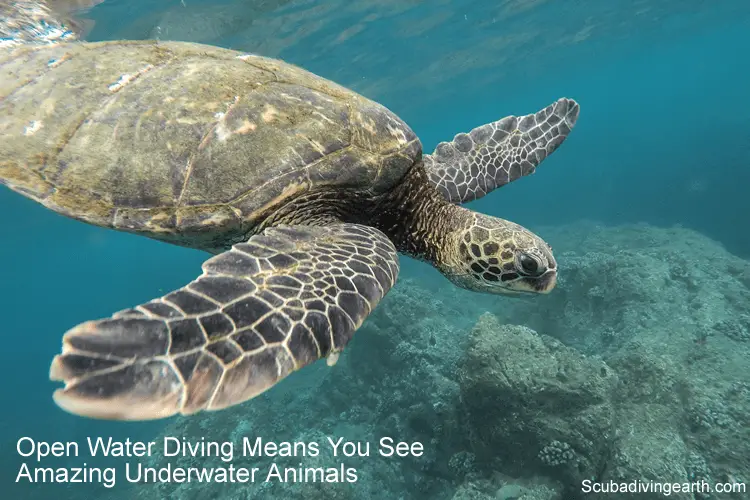
1. Scuba diving type 1 – Open water diving
The first type of scuba diving that all certified scuba divers can do is open water diving. Open water diving is the start of your scuba diving discovery journey.
When you enter the open seas and oceans around the world you’re privileged to see amazing underwater animals like the turtle in the above image.
But what is open water diving?
The term ‘Open Water Diving‘ is interpreted in slightly different ways. This interpretation depends on who you learn to scuba dive with.
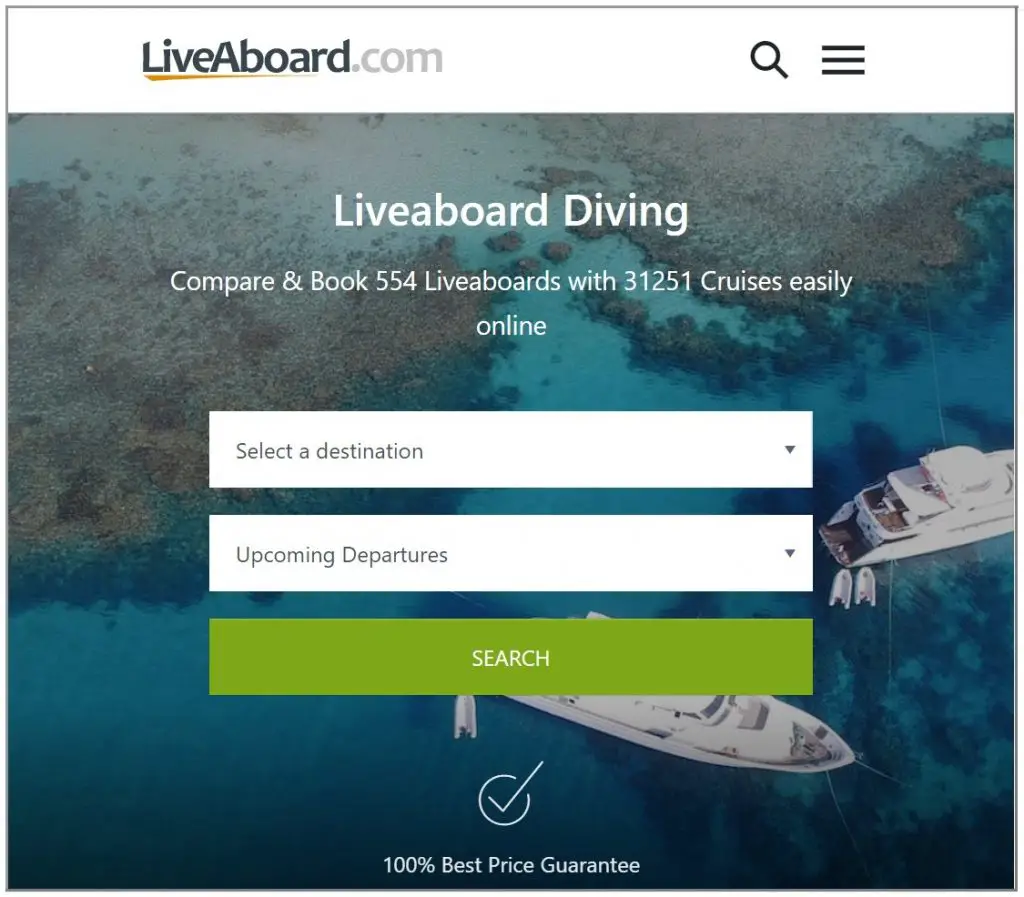
What is an open water dive?
If you look at the definition of ‘open water‘ on for example Wikipedia, they describe it as: “An expanse of an ocean, sea, or large lake which is distant from shore and devoid of nearby islands or other obstructions.”
If you look at the open water definition from the PADI dive school’s perspective. PADI include oceans and lakes as open water. Whereby their training in the swimming pool is referred to as ‘confined water dives.’ The first qualification you attain with PADI is an ‘Open Water Diver.’
However, if we then look at BSAC’s definition of open water, this is slightly different to PADI.
BSCA have three stages of training. These include ‘pool training,’ ‘sheltered water training‘ (i.e. lakes) and ‘open water.’ BSAC consider open water as the sea or ocean and don’t includes lakes in their definition. The first level of qualification for BSAC is an Ocean Diver, which reflects their view on the definition of open water.
SSI’s definition of open water refers to “Open water is any body of water other than a swimming pool.” Which of course, like PADI, includes both lakes and the sea or ocean. SSI also adopt the PADI approach, as their first beginner level of diver is also an ‘Open Water Diver‘ too.
Does it matter about the definition of open water and what’s this got to do with types of scuba diving?
Personally, I think it does matter? The view you develop as a new scuba diver of the different types of water you scuba dive in, is what sets your perspective of the way you scuba dive. But not only that, whereabouts you dive.
But why is this important?
It’s important because from a ‘Safe Diving‘ perspective you should only dive within your skill set, what experience you have and the level of scuba diver certification you’ve attained.
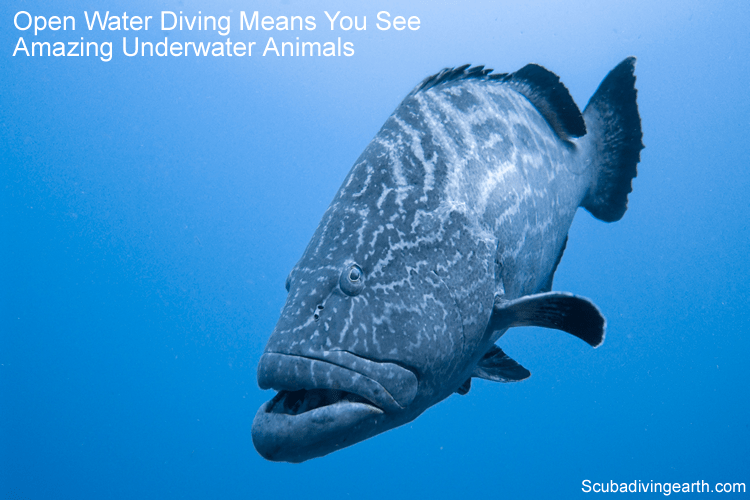
Open water dives that require different skills and experience for scuba divers
For example, if you learn to scuba dive in the lovely warm blue waters of the Caribbean. I wouldn’t suggest you rush back to somewhere like the UK (i.e. cold low visibility diving) and dive to 30 metres (98 feet) straight away. Assuming you are qualified to dive to 30 metres (98 feet).
However, on the contrary, if you learn to scuba dive in somewhere like the UK or somewhere else that has cold and low visibility water, scuba diving in the Caribbean becomes very easy.
These are two totally different types of scuba diving, even though they are both defined as ‘open water dives.’
I’m not saying this is wrong to define them in this way. But what I am saying is to carefully consider the type of open water you are diving in. There will be different considerations to take account of with each one.
The different types of open water will require different diver planning beforehand. For example, diving in colder water is better done in a dry suit rather than a wet suit. Dry suit diving requires additional training. All of this needs to be planned before the dive goes ahead.
More Reading: What is the difference between a wetsuit and a dry suit?
Why is it that BSAC don’t define lakes as open water diving?
The reason why BSCA have a separate split between ‘sheltered lakes‘ and ‘open water‘ (i.e. the sea or ocean), is that lakes are a safer environment to dive in. There are no tides or currents and the water is ‘contained.’
BSAC trainee divers are taken to a sheltered lake to perfect their skills they learn in the pool. It’s only then, after they are confident and competent in a lake, that they are taken to the open sea to further their training and experience. Which is all done under the guidance or a qualified scuba-diver-trainer.
But what if the open water sea is sheltered?
Where this extra step between the pool training and the open sea doesn’t make too much difference in terms of safe diving practices, is in open water where the ocean is sheltered.
Places like the Caribbean or Florida come to mind. It’s very easy for dive centres to find a sheltered reef to continue the scuba training after the pool lessons.
A shallow reef dive without significant tides or currents in clear water is not too dissimilar to a lake dive. Better actually, as the water is warm and probably clearer too.
What next after becoming an open water or ocean diver?

2. Scuba diving type 2 – Drift diving
A Drift dive is a scuba dive in waters where there’s a tide or current flowing that’s strong enough to push you along in the water. You go with the flow!
I personally love drift diving. It’s the equivalent of flying, but you’re underwater and weightless. It’s an effortless scuba dive and can be a lot of fun.
There are additional training aspects to a drift dive. Plus you’ll need additional scuba diving equipment too.
For diver safety, a surface marker buoy (SMB) is used for drift diving. This is a buoy that floats on the surface and is attached to the scuba diver via a hand-held line and reel. As the diver descends, the line is slowly let out until the diver reaches the bottom.
More Reading: What is a surface marker buoy used for? (Safety diving equipment)
The buoy is then dragged by the diver throughout the course of the dive. The buoy is then followed on the surface by the dive boat skipper, which means the boat is able to stay in constant sight of each diver’s position in the water.
Drift diving tips
1. Only take one surface marker buoy per buddy pair on a drift dive
Having only one surface marker buoy between buddy pairs avoids getting the lines tangled on the dive.
More Reading: How do I get a dive buddy? (5 easy ways to find a dive buddy)
2. Avoid tangling the surface marker buoy line
Be careful when navigating around obstacles on the bottom like outcrops and wrecks. You don’t want your line getting tangled.
3. Be careful not to get separated
On some drift dives you’ll be moving at quite some speed. This makes it very easy to split up from your dive buddy. Therefore be aware of the speed of the current and be extra vigilant towards your dive buddy.
More Reading: What should you and your buddy do if separated during a dive?
4. Be careful when drift diving in low visibility water
Low visibility water adds a further risk to a drift dive. The chances of splitting up with your dive buddy are greater, as it may take only a second or two to be out of sight of each other.
5. Consider a buddy link line
You may adopt the use of a buddy link-line. This provides an extra layer of safety and prevents dive buddies from separating on a dive.
6. Don’t drift dive in the night
Combining a night dive (see below) and a drift dive isn’t safe to do. Not only will it be easier to get separated from your dive buddy, although you will have dive torches, it will be extremely difficult for the dive boat to follow your surface marker buoy in the dark.
More Reading: Why use a diving torch scuba diving (It’s not just for night diving)
7. Mind your buoyancy control
Your buoyancy control can be affected on a drift dive. I suggest you master your buoyancy before you attempt a drift dive.
8. Be careful not to bump into things on the bottom
You could be travelling at quite some speed on a drift dive. So be mindful of what’s ahead of you and don’t bump into things. This includes fellow scuba divers.
9. Be careful when you stop to look at things
Be careful about stopping for too long to look at things on a drift dive. You may stop, but your dive buddy may not and they may not realise you have stopped. Before you know it, and especially in fast drifts and even more so on low visibility drift dives, your buddy will be out of sight in no time.
10. Take a delayed Surface Marker Buoy
It’s advisable for the dive buddy that isn’t holding the surface marker buoy to have a delayed surface marker buoy. This is a diver safety precaution in case of getting separated. The separated buddy will be able to deploy the delayed SMB so the boat skipper can see and follow them too. As with all dive buddy separations, both separated dive buddies must surface immediately.
More Reading: What is a delayed surface marker buoy? (Safety diving equipment)
11. Be careful on your descent or ascent on a drift dive
Be a bit more careful on your dive descent or ascent from a drift dive. This is especially true on descents where currents are stronger, as these can drag you down deeper than you planned on your descent.
12. Be aware of currents that can push you deeper
Currents can be very strong and there’s no way you would be able to swim against them. Be careful of diving where these currents could push you deeper than your planned dive depth.
13. Never fight the current
Always go with the flow and never fight the current. For one it’s usually impossible to swim against the current in any case and it’s much more fun to just go in the direction of the flow. In trying to fight the current, you’ll soon run our of air.
14. Don’t drift dive in currents that exceed 3 knots
Any currents over 3 knots are regarded as severe and too dangerous to dive. Even currents between 2-3 knots are regarded as a strong current and you’d be flying along in this speed of current!
Additional training for a drift dive
PADI and SSI have specific courses for drift diving, whereas BSAC don’t. However, it’s always advisable to dive with an experienced diver on your first drift dive whoever you trained with. BSAC incorporate in their courses a managed program of diving experience. You must stick to familiar locations and conditions you have encountered during your training as a BSAC diver.
What type of scuba divers go on drift dives?
Drift dives are suitable for all diver types. They can be enjoyed by all divers. However always consider taking the additional training that’s available before your first drift dive. Plus dive with someone who has already drift dived before and in that location.
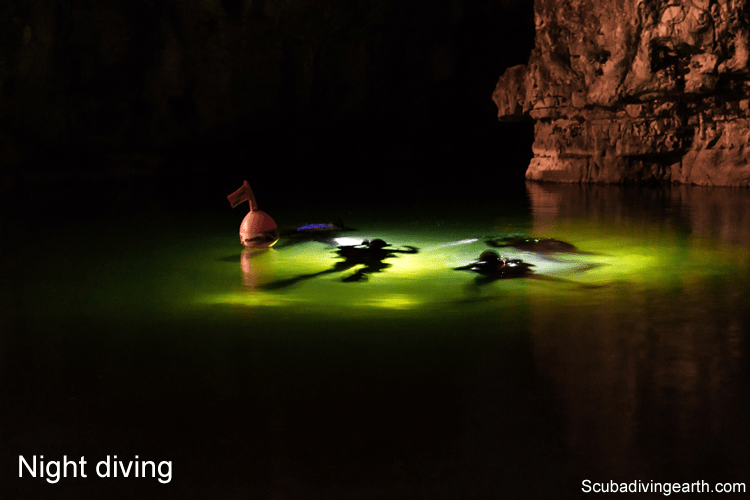
3. Scuba diving type 3 – Night diving
Night diving is one of my favourite types of scuba diving. One of my best night dives ever was on the Thistlegorm Wreck in the Red Sea.
The reason this dive on the Thistlegorm was so special is because it’s not that often this can be done. Plus I saw the biggest turtles I’ve ever seen sleeping on a platform on the wreck. These two Leatherbacks must have been nearly two metres (6.5 feet) in length.
Night diving on a reef is interesting as you see different things. Many of the day time fish are asleep inside the reef, hiding away from predators like sharks that feed at night.
However, there are other creatures that come out at night too.
Night diving tips
1. Always dive with a dive torch
This is an obvious tip, but still worth mentioning. However, it’s worth mentioning to make sure your torch batteries are fully charged beforehand.
2. Carry a backup torch
I would recommend you carry a small backup torch, just in case your main torch stops working.
3. Dive torch seal
If your dive torch is one where the battery is charged by taking it out of the torch housing, make sure you seal the torch properly when you close it. I have finished a scuba dive before now with a torch filled with sea water. This destroys a dive torch!
4. Add a diver safety strobe light to your night diving scuba equipment
A safety strobe light is a good piece of additional safety equipment to add to your night diving equipment.
5. Be careful of the coral reef
At night it’s more difficult to see, so be extra vigilant with the coral reef. Be a responsible diver and take care of the underwater world.
6. Stay in sight of your dive buddy
As with normal safe diving practice, stay in sight of your dive buddy. However, being that it’s a night dive be more aware of the distance from your buddy.
7. Try turning your dive torch or light off
It’s great to turn your torch off on a night dive. Agree with your buddy beforehand that this is what you plan to do, but both switch them off at the same time. When the dive lights are off, wave your hands in the water and the water should light up blue with the bioluminescent plankton. You are best to find a sandy bottom and settle there to carry this out.
8. Night dive signals
Signalling your buddy on a night dive is better done by shining your dive light on your hand as you give the signal.
9. Don’t shine your dive light in your buddies face
This may be another obvious tip, but it’s worth mentioning. Be careful of where you shine your dive light, as they tend to be extremely bright. Your buddy will not thank you for it and will have spots in front of their eyes for a while afterwards.
10. Know the dive site
Before any night dive and especially if you’re not on an organised trip where the instructors know the dive site, make sure you dive the site in day light first. This has two benefits. The first is you’ll get to see the dive site in the light and see what sea creatures are out in the day time, but also you’ll get to understand the layout of the dive site.
11. Shore night dive
If you are doing a shore night dive instead of a boat night dive, make sure you’ve marked the beach in some way. If there’s already some form of lighting you should be okay, but if not, you should place lights on the beach to guide you back to where you entered the sea.
Additional training for a night dive
As with drift diving both PADI and SSI have specific courses for night diving too. Whereas BSAC don’t have a specific course, but the way the training works is a student would be supervised and guided through their first night dive experience.
What type of scuba divers go on night dives?
Night dives are suitable for all diver types. They can be enjoyed by all divers. However always consider taking the additional training that’s available before your first night dive. and only dive within your level of qualification and experience.
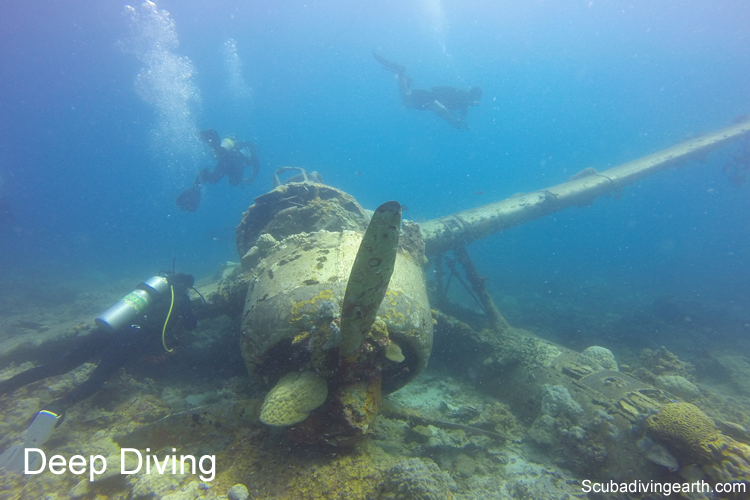
4. Scuba diving type 4 – Deep diving
The next type of scuba diving to consider is deep diving. But what is considered deep diving?
The definition of a deep dive is slightly different between the training organisations. An Ocean Diver with BSAC can dive to 20 metres (66 feet). Whereas the Open Water Diver with PADI and SSI can dive to 18 metres (60 feet).
Deeper than 18-20 metres (60-66 feet) is therefore considered deep diving.
The various depths and levels after this grade for the different dive centres varies too. For example, an Advanced Adventurer for SSI can dive to 30 metres (98 feet). However, you can take their deep diving course and increase this to 40 metres (130 feet).
With PADI the next stage is an Advanced Open Water Diver who can dive to 30 metres (100 feet). Like SSI this is increased to 40 metres (130 feet) on their deep diving course.
Whereas for BSAC the next level is Sport Diver and for this level of scuba diver qualification the depth limit is 35 metres (115 feet). BSAC don’t run a specific deep diving course, but instead you can train to the next level of Dive Leader and dive to up to 50 metres (164 feet) once qualified.
Why would you want to do a deep dive?
Deep diving is not about simply wanting to dive deeper, but instead it’s about how depth what you want to see is situated.
Many scuba divers love to wreck dive. The UK for example has more wrecks around its coast per mile of coast line than anywhere else in the world. Some of the great wrecks in the UK and around the world for that matter, Truk Lagoon comes to mind when I say that, are deep.
When I say deep, I mean more that 40 metres and many more than 50 metres.
To really experience a wreck at depth you need to consider decompression stop diving. As bottom time for deeper scuba dives is so limited on a no decompression stop dive, you don’t get to see too much.
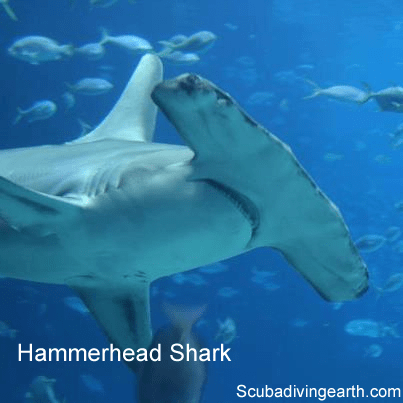
It’s not just wrecks you see at depth
There are other reasons to dive deeper than 18-20 metres (60-66 feet). For example, there are some great dives in the Red Sea where you dive deeper to see and scuba dive with sharks.
Two great examples of this is the Elphinstone Reef and The Brothers in the Red Sea. On Elphinstone Reef there’s a current that runs (but not always) north to south along the reef. The best dive is to be dropped off on the northern tip of the reef. Then dive straight down as soon as you hit the water (experienced divers only for this dive).
The dive is down to a coral plateau sitting at around 42 metres (138 feet). But with a bit of care and experienced diving, you can get to a part of the plateau at around 30 metres (100 feet) too.
If you manage to get to the plateau before being swept towards the reef itself, and then you’re able to hold on to a rocky outcrop, you’ll be blessed with the sights of sharks, which mostly include Hammerhead sharks and the Oceanic White Tip Sharks.
The recordings were made in August 2011 in Egypt – Marsa Alam. This short film is a part of “A great underwater experience”
In the video below, these are Oceanic Whitetips. They are sometimes scarily curious, as you’ll see from the video. These are often seen on this reef.
So in this case, the need of a deep dive is for visiting the exciting wildlife when you’re down there.
Deep diving comes with risks
The deeper you dive, the more risks are associated with the dive. This article Emergency decompression stop vs safety stop, I go into a bit more detail about deep diving and decompression stops.
However, in brief, all dives are decompression dives, as our bodies are subject to pressures that are much higher than we experience on land. This pressure has an effect on the air we breath at depth. It means that the nitrogen is dissolved into our body tissues and needs time to release from the tissues on ascent.
If a scuba diver ascends too fast, they risk bubbles forming which can be dangers. This is what’s referred to as The Bends or Decompression Sickness. The deeper the dive, the more and the quicker nitrogen gets dissolved into our body tissues.
This means that either the dive time has to be cut short or the dive must include decompression stops. By including decompression stops into your dive profile, you increase the risk. There are also a number of decompression risk factors to consider before you dive deep too.
Deep diving is not for everyone, but it’s great for what you get to see. If you don’t include deep diving in your scuba diving experience, you may be excluding some exciting dives. However, you can enjoy some really excellent dives at shallower depths too. Some of my best dives have been in less than 15 metres (50 feet).
Deep diving tips
1. Deep diving is about safety first
As with all diving, safety is the top priority. However, as the risks are higher on a deeper dive, you should be more careful.
2. Planning your deep dive
As with all dives, a deeper dive should be carefully planned. If the deep dive involves decompression stops, these need to be worked into the dive plan. The amount air of needed for the bottom time, for the ascent time and the decompression stop(s) time all needs to be taken account of.
3. Don’t dive deeper than your qualification level
Never dive any deeper than you’re trained and qualified to do. This is for your own safety and your travel insurance will only cover you to the depth of your qualification.
4. Check your travel insurance
Most travel insurances limit scuba diving to a depth of 30 metres (100 feet). Never dive beyond your insurance limit, but if you want to dive deeper then take out specialist scuba diving insurance.
5. Back up air supply
When you dive deeper, its a good idea to carry a spare air supply or ‘Pony Cylinder.’ This is only to be used in an emergency, and not for a planned ascent and decompression stops.
6. Consider a technical diver course
Consider additional scuba diver education to learn how to dive with mixed gasses. These extend your range and will allow you to dive deeper to explore those wrecks at deeper depths.
7. Consider a rebreather
A good option for deep diving is a rebreather. These require additional training, but are a good option for extending your dive time. However, you’ll still need to carryout decompression stops on longer deep dives.
8. Use a delayed surface marker buoy
Many wreck dives will either have a fixed line to descend and ascend with or the dive boat will send down a line or their anchor. But if this isn’t the case (for example, you’re diving from a rib), then always take a delayed surface marker buoy (Surface Sausage), to ascend with at the end of the dive. This makes your ascent safer and easier and helps with decompression stops.
9. Watch your dive time carefully
At depth your air consumption increases. Be careful to monitor your air consumption very carefully.
10. Watch your bottom time
At depth your ‘no decompression stop time,‘ or the time you must stop for decompression on a decompression-stop-dive creeps up and speeds up very quickly once you move into this zone. Watch this very carefully in conjunction with your air consumption and reserves. You need to ensure you have enough air to reach the surface with the correct decompression stops.
11. Dive with better thermal insulation
The deeper you go the more likely you are of getting cold. This is especially true when diving with a wetsuit. The neoprene of a wetsuit gets crushed at depth and loses its insulating properties. If you are diving in colder water always dive in a dry suit at depth. You will be warmer.
More Reading: Does a dry suit keep you dry (What are the exceptions & do you get wet)
What type of scuba divers go on deep dives?
Deep dives are for the more qualified and experienced diver. You are limited to 40 metres with PADI and SSI for recreational diving, whereas you can dive to 50 metres as a Dive Leader with BSAC. However as a BSAC Advanced Diver you can go beyond 50 metres (164 feet) as a technical diver after following the appropriate training.
PADI also has a technical diving course where you can dive to 50 plus metres and even up to 100 metres (328 feet) taking their Tec 100 CCR course. SSI have a similar course to also extend the range of your diving and become a technical scuba diver too.
5. Scuba diving type 5 – Wreck diving
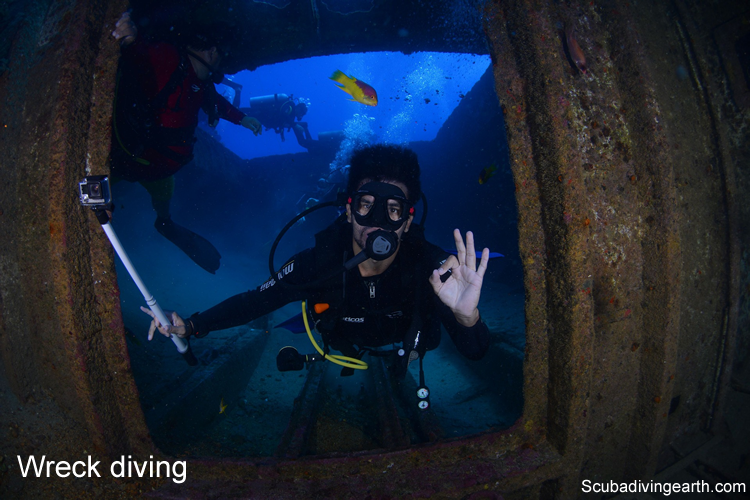
I’ve already touched on wreck diving in the previous section on deep diving.
Wreck diving isn’t for everyone, but most divers enjoy a good wreck. What I love about them is the sea life that accumulates around the wreck. I’m not so hook on the wrecks themselves, unless it’s in clear blue water and you can see the whole wreck.
Many UK divers will dive on wrecks in dark murky waters (I’ve done this myself) and enjoy it. However, this is the type of scuba diving I don’t enjoy.
For me it’s dark, cold and all you mostly see is lumps of rusting metal that barely looks like a wreck. Not always the case, and you have to experience this for yourself you decide.
Scuba diving treasure hunt
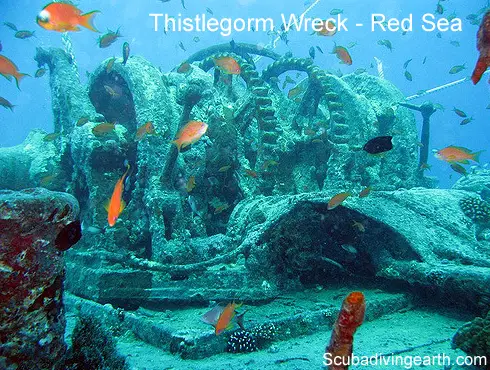
Some scuba divers collect goodies from wrecks, like portholes and other brass wear for their homes. This is for some like a treasure hunt. Some love to have a port hole on the mantle in their home. But one they’ve found rather than bought at a shop.
If you love the idea of finding some form of treasure trove on a wreck, then this might be your bag. But you have to be careful about what you take.
However, this is not my thing either. I prefer to leave things as they are for other divers to enjoy. If everything is taken from a wreck, it leaves it bare and uninteresting, except for the wildlife that colonises the wreck.
For me it’s all about the wildlife. So for example when I dive on wrecks in the UK, I’m looking for Conger Eels, crabs and lobsters.
And in sunnier climbs and warm blue water wrecks, looking out for the usual sea life that inhabits a wreck in these waters.
As already mentioned in this article, my favourite wreck is the Thistlegorm wreck. Originally dived by my childhood idol and pioneer scuba diver Jacques Cousteau.
If you get the opportunity to dive the Red Sea, definitely dive this wreck. It was sunk in the Second World War on 6th October 1941.
Wrecks are not just ship wrecks
The wrecks to scuba dive are not just ship wrecks. These can include planes, cars, tanks and even double-decker buses!
Wreck diving tips
- Leave the wreck as you found it – Unfortunately, there are many divers that want to take things from wrecks and destroy them. I don’t believe this should be allowed. This is not permitted in the Red Sea, which is great, so all divers get to experience the wreck in its full glory.
- Don’t penetrate the wreck unless – Wreck penetration is fraught with danger. So never enter a wreck unless the entry has been pre-planned and you can see the exit and you have experience in this. You have to be careful on entering wrecks, st they can be unstable and any disturbed silt inside the wreck can completely block your vision and disorientate you.
- Use penetration lines – If you are to penetrate a wreck without a clear exit point, you should use penetration lines for safety.
- Remember a wreck becomes a home – All wrecks become a home to underwater creatures. Respect the home of these creatures and don’t disturb them anymore than you have to.
- Respect the wreck – Most wrecks are a grave site, so you should respect them as such. Often times lives were lost when the ship sank.
- Always take a dive torch or light – Essential scuba equipment for a wreck dive is a dive torch or light. All wrecks have holes and places to explore and light up. The holes are home to all sorts of underwater wildlife.
Additional training for a wreck dive
Both PADI and SSI offer additional training for wreck diving.
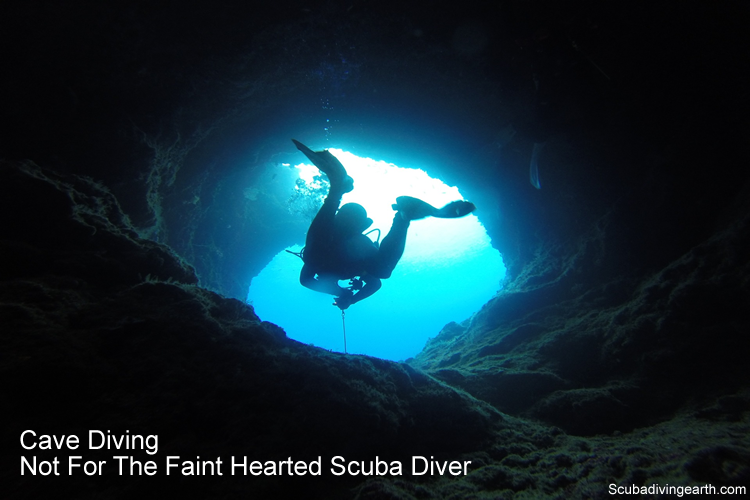
6. Scuba diving type 6 – Cave Diving
Cave diving is a very specialist type of scuba diving.
Diving in caves is probably considered to be the most dangerous of all sports in the world. Cave divers dive in water-filled caves and in many cases the caves are dived as part of scientific investigations.
Generally speaking, cave divers will usually require more specialist diving equipment. This would include additional scuba air tanks.
Cave divers are technical divers. The reason why this extreme sport is consider more dangerous is due to the lack of being able to ‘free-surface.’ What I mean by that is that unlike a dive in ‘open-water,’ where you would be able to freely return to the surface, when you’re diving in a cave, this is simply not possible.
Above you will be the cave’s ceiling, and the only way out is to return to the cave entrance. The way out may be a long way back from where you’ve ventured into the cave. Should you encounter a problem, you’ll not be able to simply ascend to the surface.
What about cave diving as a recreational sport?
If you want to include cave diving as your recreational sport, you may struggle to find dive buddies to explore with you.
You will also find that if you take out holiday insurance, this will exclude cave diving. This is due to the extreme nature of this type of scuba diving.
So to obtain diving insurances as a cave diver will be more difficult and more expensive. One of the main considerations of cave diving, apart from making sure you don’t get lost inside the cave, is decompression.
Your cave dive must take account of your air consumption amount and time needed for your decompression time.
What attracts scuba divers to cave diving?
Despite the huge risks associated with cave diving, scuba divers are still attracted to this type of diving.
Deep water-filled caves attract scuba divers for some (or all) of the following reasons:
- Because they are cavers or speleologists – Speleologists are cave scientists and study caves.
- Some scuba divers love to take advantage of a cave’s unexplored depths.
- Explorer scuba divers love the idea of diving where no one’s ever dived before.
- The excitement of new discoveries.
- Caves present divers with a technical diving challenge.
- Underwater caves have a wide range of physical features which are different to open-water diving.
- Caves may often contain fauna that’s not found anywhere else.
Cave diving is not for everyone and not for the faint hearted. But if it’s something you are interested in, you can make some serious money as a speleologist, or actually as a geoscientist in general.
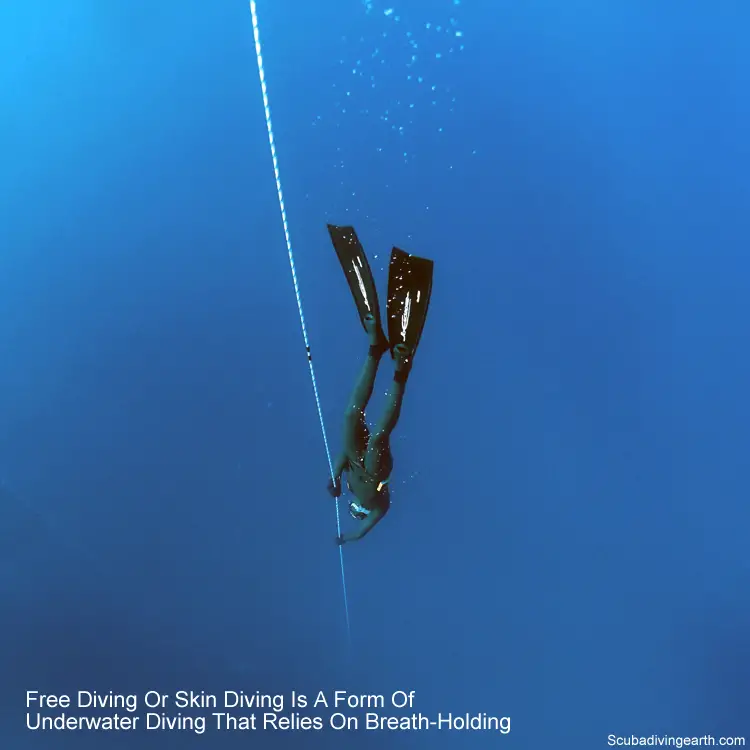
7. Scuba diving type 7 – Free Diving
Free diving, which is also known as skin diving, is a form of underwater diving that, instead of relying on an aqualung, relies on breath-holding.
Whilst with scuba diving you are taught to never hold your breath, but with free diving it’s the complete opposite.
With free diving it’s about how long you are able to hold your breath for. The longer you can hold your breath, the longer and potentially the deeper the free dive.
The extreme of free diving where competitions are held involves diving down to huge depths and to hold your breath for extreme periods. The record holder for the deepest free dive is Austrian diver Herbert Nitsch.
His maximum depth was to 253.2 metres (831 feet) back in June 2012.
However, free diving does not only involve competition diving. Free divers also use this sport to spear fish and is generally used by snorkelers too.

8. Scuba diving type 8 – Ice Diving
For ice diving you have to be prepared to scuba dive in icy cold water. Cold water diving is not for everyone. It is also considered one of the most adventurous types of scuba diving too.
One of the wonders of ice diving is to see the underside of ice. See the stunning shapes and colours of underwater ice. Ice diving is dangerous and similar to cave diving. This is due to the fact you can’t come straight to the surface.
With ice diving you will dive through a cut-hole in the ice. In order to return to the surface, you’ll need to find your way back to the same ice-hole.
Ice diving is very much reliant on a team effort. It also relies on having specialist equipment like safety lines. But it’s also about making sure your equipment doesn’t freeze. In freezing water, a scuba diver’s mouthpiece (or regulator) can freeze and cause a free-flow.
What are the different types of scuba diving certifications?
There a number of scuba diving certifications around the world. In this article “how to scuba dive without certification,” I run through the top scuba diving schools. By the way, in this article I don’t advocate scuba diving without certification, as this is dangerous – my recommendation is to get your scuba diver certification before even considering scuba diving.
The top three scuba diver certifications include PADI, BSCA and SSI. These were chosen with the following in mind; ease of access around the world and on the quality of the training.
Who you get certified to scuba dive with will depend on where you live in the world. By far PADI is the most accessible, as they have over 6,400 dive shops or centres around the world where you can learn to scuba dive.
The next scuba diving certification which has a large number of locations to learn scuba diving around the world is SSI. SSI are represented in more than 110 countries with over 2,800 international locations with diver centres.
BSAC is an excellent and a very safe way to learn how to scuba dive. BSAC for example take diver rescue very seriously right from the outset, whereas the other training organisations don’t. So even with the very basic Ocean Diver qualification, beginner scuba divers are taught diver rescue skills.
I hope you enjoyed this article about what are types of scuba diving
I’d love to hear from you. Tell us about your adventures of diving and snorkeling, in the comments below. Please also share your photos. Either from your underwater cameras or videos from your waterproof Gopro’s!
If this article hasn’t answered all of your questions. If you have more questions either about snorkeling or scuba diving (or specifically about what are types of scuba diving), please comment below with your questions.
There will also be many more articles about scuba diving (and snorkeling) for you to read and learn about these fabulous sports.
Have fun and be safe!

